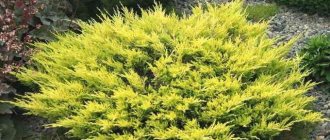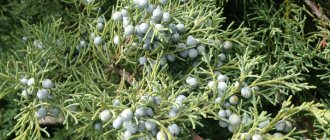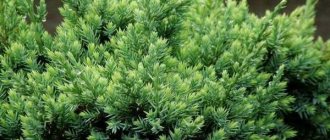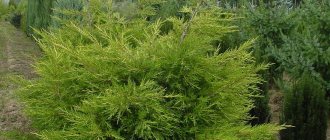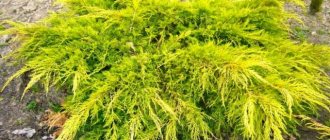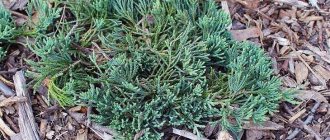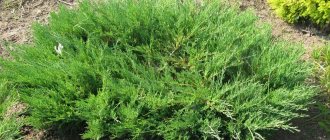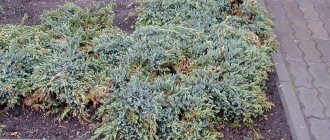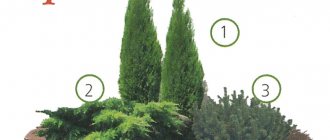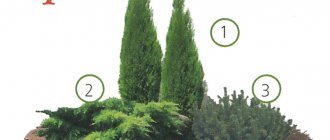General information and description of the plant
Juniper is a representative of evergreen shrubs and trees from the Cypress family. In different regions of Russia the plant is known under different names. It is called Veres, Walrus, Yalovets and Bruzhevelnik. The usual term “Juniper” is associated with the place of growth - the undergrowth of spruce forests, “between the spruce trees.”
Fruits of the plant
General information and characteristics of the plant:
- cypress family, genus juniper, evergreen
- dioecious, in rare cases monoecious
- long-lived, up to 3000 years. Slow growth
- The diameter of the oldest tree does not exceed 15 centimeters
- small shrub or tree
- the height of some species reaches 12 meters
- distinguish female and male species
- softwood
- flowering period – May
- superficial position of lateral roots
- most species are stress-resistant and tolerate low temperatures
- Some species are listed in the Red Book and are protected
All types are distinguished by their unique air purification properties. Juniper produces six times more phytoncides than other conifers.
In nature, representatives of the family can be found in different parts of the planet; they occupy vast areas. Juniper grows throughout Europe, the United States of America, the Mediterranean and Asia. It is successfully cultivated in gardens and summer cottages. Some specimens grow in hard-to-reach areas, on mountain slopes. Today the genus consists of 75 species.
Common or Juniperus communis
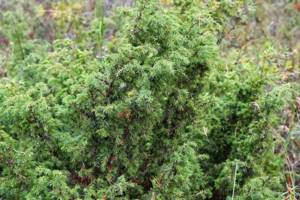
Common juniper in its natural habitat
Common Juniper or Juniperus communis
- The most widespread species, occupying vast areas.
- A shrub or small tree easily takes root and develops in various soils.
- Sandy and limestone soil is preferred for cultivation.
- A distinctive feature was the stress resistance of the family member.
- It tolerates severe air pollution and is resistant to temperature changes, heat, bright sunlight, shade and frost.
- The height of the plant is up to 12 meters, the crown can take different shapes.
- The color palette of the shoots is brown with shades of red, the cones are distinguished by a dark blue-black color.
- The prickly, needle-like needles covering the branches reach 16 millimeters in length.
- The size of the fleshy, round-shaped cones is up to 9 millimeters.
Green Carpet

Green Carpet or Green Carpet
Green Carpet
- One of the varieties of common juniper was discovered at the end of the 20th century on the coast of Norway.
- The name is associated with the ground cover quality of the variety; it grows up to two meters in diameter.
- The dense crown takes on a round shape due to the horizontal direction of the branches.
- The low-growing variety reaches a maximum height of 30 centimeters.
- The color palette of pine needles is rich green, emerald.
- When cultivating, planting in the partial shade zone and a strong decrease in air temperature is permissible.
- Dry air negatively affects the development of bushes.
Pencil Point or Pencil Point
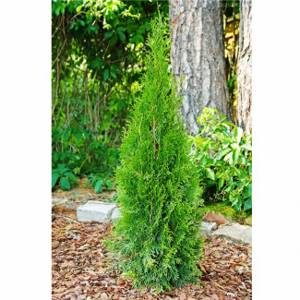
Pencil Point or Pencil Point
Pencil Point or Pencil Point
- The name is associated with the pencil-shaped shape of the Pencil Point variety and its pointed tip.
- The plant appeared thanks to the work of Canadian breeders.
- At the age of 10 years, the height of the tree reaches 1.5 meters.
- The molded appearance of the crown ensures a near-trunk arrangement of upward-pointing branches.
- Green, small needles retain their brightness throughout the winter period.
- Single trees or groups of Pencil Point trees are planted on personal plots.
Gold Cone or Gold Cone
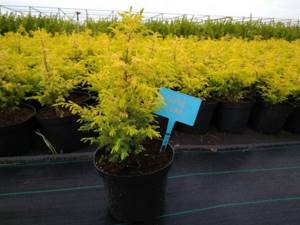
Seedlings Gold Con
Gold Cone or Gold Cone
- The variety of common juniper, popular in landscape design, became the work of German selection.
- The plant is up to three meters high and up to sixty centimeters wide and has an unusual pyramid-shaped crown.
- The disheveled crown formed by the oblique arrangement of upward-pointing branches gives a special charm.
- The color of the needles changes depending on the season: spring and early summer are yellow, winter is brown, and summer is green.
Root and cones
The Northern Hemisphere is home to the common juniper. Its needles love light, nutritious soil and bright sunlight. Juniper tolerates drought well; it needs to be watered three times in hot weather. It grows up to 15 m in height. This tree is long-lived.
Planting methods: seeds, cuttings, layering and grafting.
The young tree has needle-like leaves. When it matures, it becomes scaly in appearance. The buds have no scales, they are bare. Sometimes, with the help of short leaves, the buds are pressed against the branch. The color of the needles is most often greenish-blue. The sharp ends of the needles are in the form of a needle, which has three sides. Male spikelets grow in the form of stamens. They are covered with scales and arranged in pairs. An anther opens at each stamen. Female spikelets have one or two ovules. They consist of carpels. The cones look like gray or blue balls. The cones have very densely arranged scales. An ordinary juniper has from 1 to 10 seeds, which are located separately. Cones are formed in the second year of the plant's life. The root system is axial. When planting in a dacha, it is necessary to maintain its integrity so that the tree does not get sick.
Use in cooking:
- For making tea;
- Making tincture;
- Regular kvass.
Cone-shaped, spherical, pyramidal or creeping - this can be the shape of the crown of a bush or tree. This variety expands the possibilities for landscape design to create compositions that are expressive and impressive in their geometry.
Cossack species or Juniperus sabina

Juniperus sabina
Cossack species of juniper or Juniperus sabina
- One of the most stress-resistant species, growing freely in Europe and Asia.
- The varieties are resistant to temperature changes, severe air pollution, high and low temperatures.
- A distinctive feature has become the reason for the frequent planting of the plant along the roads of megacities.
- The creeping shrub reaches a maximum height of 1.5 meters.
- Dark green, dense needles form a spreading crown.
- Color may vary depending on the variety.
- When choosing a plant for planting in a summer cottage, it is necessary to take into account its toxic qualities.
Tamariscifolia or Tamariscifolia

Tamariscifolia
Variety Tamariscifolia or Tamariscifolia
- This popular variety of perennial plant is distinguished by a spreading, dense, squat crown.
- An undemanding plant easily takes root even in poor soils.
- In the wild, it is found on steep cliffs and at an altitude of up to 3.5 meters above sea level.
- The stress-resistant plant reaches a height of up to two meters.
- Needle needles retain their greenish-blue color all year round.
- Ripe bluish-green cone berries are not suitable for consumption and are poisonous.
Blue Donau or Blue Donau
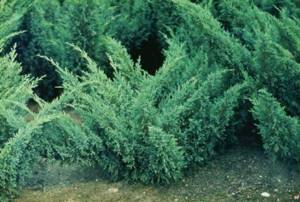
Blue Donau
Blue Donau or Blue Donau
- The maximum height of the bush reaches three meters.
- The variety is distinguished by the unusual blue color of its small needles.
- In winter, the crown changes color and acquires a green or purple tint.
- The plant is not fussy; a novice gardener can handle cultivation and care.
- By two years, the cones acquire a bluish color similar to pine needles.
- The plant tolerates urban conditions well and is resistant to weather changes.
Middle view or Juniperus media
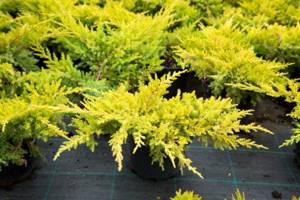
Juniperus media
Middle view or Juniperus media
- An artificially created species, the result of crossing the Chinese and Cossack species.
- The powerful shrub reaches a height of three meters and is distinguished by hanging shoots.
- The needles are bright green in color.
- Juniper branches are directed upward at an oblique angle.
King of Spring or King of Spring
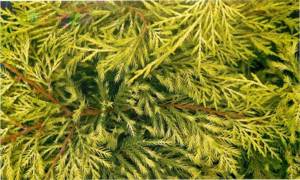
King of Spring
King of Spring or King of Spring
- Low-growing variety, height does not exceed 50 centimeters.
- Spreading branches are located at an angle and look in different directions, the size of the crown in diameter reaches 1.2 meters.
- Fluffy needles of bright green-yellow color attract attention and look impressive.
Virginia species or Juniperus virginiana
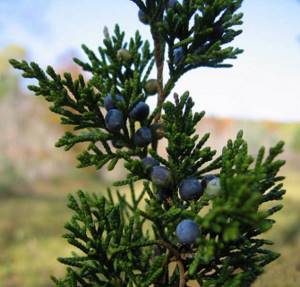
Juniperus virginiana
Virginia juniper or Juniperus virginiana
- An evergreen species of juniper native to North America.
- In the wild, it can often be found on rocky terrain.
- Depending on the variety, there are horizontal bushes or vertical, low-growing trees.
- The needles of the plant come in different colors, in most cases with black-blue cones.
- The species is frost-resistant, tolerates a lack of moisture and sun, and is not picky about the composition of the soil.
- Today, about 70 varieties of Virginia juniper are known.
Canaertii or Canaertii

Canaertii
Canaertii or Canaertii
- The variety was the result of the work of Belgian breeders.
- A tall tree with a sharp pyramidal crown appeared in the 19th century.
- The color palette of the needles is bright green, with a yellow tint appearing in winter.
- Over time, the crown loses density.
- Cone berries with a white coating add attractiveness to the plant and stand out in a bright blue color.
Gray Owl or Gray Owl
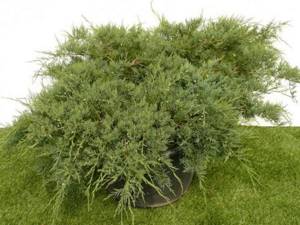
Gray Owl
Gray Owl or Gray Owl
- The variety appeared in 1938 thanks to Dutch breeders.
- The lush plant stands out with its irregularly shaped crown.
- The height of the bush during the first 10 years of growth does not exceed 1.5 meters.
- Gray Owl attracts attention with the pleasant color of its scaly needles.
- The dove-blue color looks impressive when planted individually or in groups.
Juniper tall
This tree crop is a relic of the Tertiary period, growing for more than fifty million years over a vast territory of almost all of continental Europe. Today, the natural spaces of the common juniper have been reduced to the parameters of nature reserves. The tree is short, light- and heat-loving, and quite drought-resistant. It has a rounded pyramidal crown, thin arched branches and brown, cracking, and in some places completely flaking bark. The needles are leathery and dense, green-gray, with characteristic purple cones with fleshy fused scales. The wood has a brownish-pinkish hue and a smooth texture, polishes well and smells aromatic.
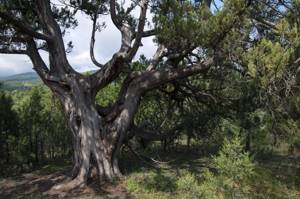
Horizontal view or Juniperus horizontalis
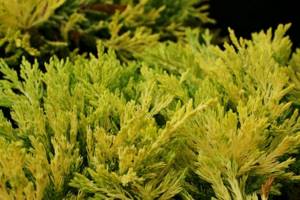
Juniperus horizontalis
Horizontal view or Juniperus horizontalis
- The name of the species is associated with external features.
- The low-growing shrub, pressed to the ground, has needles of a green palette and with a burgundy tint in winter.
- In the wild, the plant is found on the North American continent.
- To date, about 60 varieties of Horizontal juniper have been bred through selection.
Icy Blue or Icee Blue
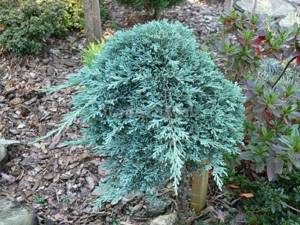
Ice Blue
Icy Blue or Icee Blue
- Juniper Icy Blue attracts attention with its small, dense needles of a deep blue hue.
- The height of the creeping shrub does not exceed 15 centimeters, and the scale-like crown reaches two meters in diameter.
- The appearance of the plant resembles a living carpet, which was the reason for the name of the variety.
Golden Carpet or Golden Carpet
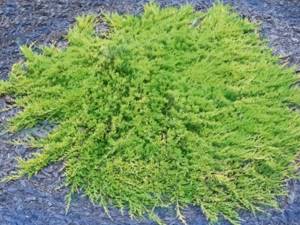
Golden Carpet
Golden Carpet or Golden Carpet
- The popular variety of Horizontal juniper has a bright color palette.
- The color of the creeping, dense crown attracts attention with a rich golden-yellow hue.
- In adulthood, the plant does not exceed 30 centimeters in height.
- An unpretentious representative of the family has needle-type needles and reaches a maximum diameter of 1.5 meters.
Chinese species or Juniperus chinensis

Juniperus chinensis
Chinese species or Juniperus chinensis
- The name is associated with the plant's distribution zone - China and Japan.
- The variety appeared in Europe at the beginning of the 19th century.
- In the wild there are specimens up to 10 meters in height.
- The scale-like or needle-like needles have a rich green color all year round.
- The species has about 60 varieties, differing in appearance and cultivation characteristics.
- Hybrids of Chinese juniper, distinguished by their two-color color, are in particular demand.
- Most varieties are unpretentious and grow successfully in poor soils.
Plumosa or Plumosa

Variety Plumosa or Plumosa
- The hybrid variety is distinguished by an unusual crown shape in the form of a crown or arch.
- The original appearance is created by spreading branches with dense scaly needles.
- The height of the plant does not exceed 1.5 meters.
- All year round, Plumosa juniper stands out as a dense, bright green color.
Strict or Stricta
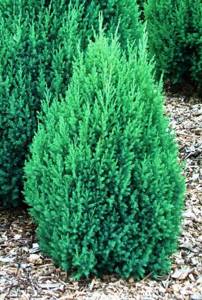
Strict
Strict or Stricta
- The shrub with a maximum height of 2.5 meters is distinguished by a cone-shaped crown with a diameter of up to two meters.
- All year round the plant pleases with its bright green-blue color.
- A long-liver among the plant kingdom, it is not picky about the soil and can go without watering for a long time.
- Strict juniper requires long sunny days.
- The average lifespan of the plant was one hundred years.
Types and popular varieties of juniper: photos, names and descriptions
Juniperus chinensis - Chinese juniper.
Grows in China. Mongolia and Japan.
In nature, it is a tree up to 20 m high or a shrub with a free-growing, broadly pin-shaped or creeping crown. Naturally, the size and type of crown depend solely on the growing conditions - the more favorable they are, the larger the plant. It is not surprising that Chinese juniper has a huge number of cultivars.
The branches of natural forms are thin, simultaneously with two types of needles on the same plant - scaly and needle-shaped. The scaly needles are tightly pressed to the branches and have a rhombic shape, while the needle-shaped needles are collected in whorls. The ends of the branches of young growth are straight and covered with scaly needles.
As you can see in the photo, the needles of “wild” juniper trees are dark bluish-green, while those of varietal trees are very diverse, including golden:
Male and female plants may vary. The fruits (cone berries) are brown with a mealy ring, round, 6-8 mm in diameter. They ripen in the second year. Natural varieties are quite frost-resistant, but in severe winters they freeze slightly. The degree of frost resistance of varieties varies, but most of them are quite resistant.
Many cultivars of the coniferous juniper plant have a controversial origin, are considered hybrids with Cossack juniper (J. sabina) and are called medium juniper (J. media). Often these varieties are classified as either one species or another, but most often to the Pfitzeriana varietal group, including such popular cultivars as Gold Coast and Old Gold.
In the conditions of the Moscow region they can actively grow. But in unfavorable snowy winters, fractures and broken branches are quite common. When growing these junipers, even well-rooted and overgrown specimens can suffer from the spring sun and drying winds. They feel more comfortable in conditions with high air humidity.
Popular varieties of Chinese juniper:
Juniperus chinensis Expansa Aureospicata
Wide, tiered growth form. The needles are needle-shaped. Grey-green. The branches are pointed, some of them ending in creamy-golden growths. Estimated dimensions at 10 years of age: width 1.5-1.8 m; height 40-60 cm. Completely frost-resistant. Damage to the needles from the rays of the spring sun is possible.
Juniperus chinensis Parsonii
Widely spreading, tiered growth form. The needles are needle-shaped. Grey-green. The branches are pointed. Estimated dimensions at 10 years of age: width 3.0 m; height 50-70 cm. Completely frost-resistant. Damage to the needles from the rays of the spring sun is possible.
Juniperus chinensis Pfitzeriana Aurea
Widely spreading, tiered growth form.
Look at the photo - the needles of the juniper plant are soft, needle-shaped, golden:
The vegetative shoots are bright and turn green over time. The branches are pointed. Estimated dimensions at 10 years of age: width 2.0-2.2 m; height about 1 m. Completely frost-resistant. Damage to the needles from the rays of the spring sun is possible.
Juniperus chinensis Pfitzeriana Blue and Gold
Tiered, pot-like growth form. The needles are soft, needle-like. Gray-blue, with golden spots. The branches are pointed. Estimated dimensions at 10 years of age: width up to 1.5 m; height 1 m. Completely frost-resistant. Damage to the needles from the rays of the spring sun is possible.
Juniperus chinensis Pfitzeriana Compacta
Tiered, creeping, flattened growth form. The needles are soft, needle-shaped, gray-blue. The branches are pointed. Estimated dimensions at 10 years of age: width 1.5-2.0 m; height about 50 cm. Completely frost-resistant. Damage to the needles from the rays of the spring sun is possible.
Juniperus chinensis Pfitzeriana Gold Star
Widely spreading, tiered growth form. The needles are soft, needle-shaped, golden. The branches are pointed. Estimated dimensions at 10 years of age: width 2.0-2.2 m; height is about 1.0 m. When describing the juniper plant of this variety, it is worth noting its complete frost resistance. Damage to the needles from the rays of the spring sun is possible.
Juniperus chinensis Pfitzeriana Golden Saucer
Widely spreading, tiered growth form. The needles are soft, needle-like. Light green-golden. Vegetating shoots are bright and turn green over time. The branches are pointed. Estimated dimensions at 10 years of age: width 2.0-2.5 m; height about 1.0 m. Completely frost-resistant. Damage to the needles from the rays of the spring sun is possible.
Juniperus chinensis Plumosa Aureovariegata
Dwarf form. The needles are green-blue. The branches have white-cream tips and have a somewhat vertical growth direction. Estimated dimensions at 10 years of age: width 60-80 cm; height about 50 cm. Completely frost-resistant. Damage to the needles from the rays of the spring sun is possible.
These photos show varieties of Chinese juniper, the names of which are given above:
Juniperus communis - Common juniper
A highly variable species, distributed in the forests and mountains of Europe, Northern Asia to Northern China and North Africa.
A columnar or pin-shaped tree or a multi-stemmed shrub with a height of 2 to 20 m. Just like many other junipers, the type of crown depends on the growing conditions, so in mountainous areas you can find forms with an elfin crown spread on the ground. The diversity of natural types has led to the emergence of a huge number of cultivars - varieties with different strength and type of crown growth.
Pay attention to the photo - this type of juniper has green, triangular young shoots with longitudinal grooves:
The bark of adult plants is gray-brown and fibrous. The needles are needle-shaped, hard, prickly, collected in whorls of 3 pieces. The length of the needles is 10-15 mm, the color is green with a white stripe in the center.
Male and female plants do not differ in appearance. The fruits (cone berries) are dark gray, as if covered with frost, round, 6-9 mm in diameter. They ripen in the 2-3rd year. Common juniper is one of the most frost-resistant of its kind. Most varieties are also completely frost-resistant, but many columnar forms suffer greatly from the spring sun and require shading.
Recommended varieties of common juniper:
Juniperus communis Berkshire
Mini variety of common juniper. The needles are prickly, pointed, gray-blue. Annual growth is within 3-5 cm. Completely frost-resistant.
Juniperus communis compressa
Mini variety of common juniper. Columnar shape. This variety of common juniper has prickly, pointed, green-blue needles. The branches fit tightly to the trunk. Annual growth is within 3-5 cm. On the south side, it is desirable to shade the plant from the rays of the spring sun. Completely frost-resistant.
Juniperus communis Dr.U.
A narrow-columnar variety of common juniper. The needles are prickly, pointed, green. The branches fit tightly to the trunk. The crown is very dense. Annual growth is within 15-20 cm. It is desirable to shade the southern part of the plant from the rays of the spring sun. Completely frost-resistant.
Juniperus communis Spotty Spreader
A dwarf variety of common juniper. Widely creeping, shrubby form. The needles are soft, green, with irregular white staining. It is desirable to shade the south-facing part of the plant from the rays of the spring sun. Completely frost-resistant.
Juniperus communis Sterling Silver
A dwarf variety of common juniper. Creeping form. The needles are prickly, gray-blue. Completely frost-resistant.
Juniperus communis Suecica Aurea
Mini variety of common juniper. Columnar shape. The needles are prickly, pointed, green-golden. The branches fit tightly to the trunk. Annual growth is within 3-5 cm. It is desirable to shade the southern part of the plant from the rays of the spring sun. Completely frost-resistant, covered with frost, round, 8-12 mm in diameter. They ripen in the 2nd year.
Completely frost-resistant. It has a few varietal forms.
Recommended variety of juniper crowded:
Juniperus conferta All Gold
A dwarf variety of crowded juniper. Creeping form. The needles are prickly and golden. Annual growth is within 5-8 cm. Frost-resistant.
Juniperus conferta - Crowded Juniper
It grows on the sands in Japan and on Sakhalin Island, forming dense thickets.
Creeping, strongly creeping shrub, similar to the elfin form of common juniper. When describing this type of juniper, it is worth noting its very long, red-brown branches. The ends of the branches are straight. The needles are light green, needle-shaped, hard, prickly, collected in flat whorls of 3 pieces. Male and female plants do not differ in appearance. The fruits (cones) are dark blue, exactly
Juniperus horizontalis
It grows in the mountains and along the sandy shores of large lakes in North America.
Creeping shrub with long branches tightly pressed to the ground. The branches are numerous and flat. The needles of the natural form are scaly, tightly pressed to the branches; in cultivated forms they are different: scaly, needle-shaped or combined. The color of the needles of the natural form is bluish-green, while the varietal ones are very diverse: green, bluish, golden, variegated.
The fruits (cones) are blue, as if covered with frost, round, 5-6 mm in diameter.
Recommended varieties of horizontal juniper:
Juniperus horizontalis Blue Pygmy
Micro variety of horizontal juniper. The needles are prickly, green-blue, sometimes silvery, densely located on the branches. Annual growth up to 1 cm. Completely frost-resistant.
Juniperus horizontalis Golden Carpet
Creeping form of horizontal juniper. The needles are scaly, golden, light green at the base of the branches. In winter it turns brown. Annual growth within 10 cm, completely frost-resistant. The decoration of the garden will be both a juniper grown on a trunk and hanging from it, and a specimen spreading along the ground.
Juniperus horizontalis Mother Lode
Creeping form of horizontal juniper. The needles are scaly, golden, slightly light green at the base of the branches. During the summer it gradually acquires brownish tones, turning completely brown in winter. Annual growth within 10 cm. Completely frost-resistant. The decoration of the garden will be both a juniper grown on a trunk and hanging from it, and a specimen spreading along the ground. Considered one of the most golden junipers.
Juniperus horizontalis Neumann
Micro variety of horizontal juniper. The needles are prickly, blue-green, sometimes silvery, densely located on the branches. Annual growth up to 1 cm. Completely frost-resistant. Almost indistinguishable from Juniperus horizontalis Blue Pygmy.
Look at the photo - this variety of juniper is considered the smallest:
Juniperus horizontalis Prince of Wales
Creeping form of horizontal juniper. The needles are scaly, green-blue. Annual growth is more than 10 cm. Crown diameter at the age of 10 years is more than 2 m. Completely frost-resistant. The decoration of the garden will be both a juniper grown on a trunk and hanging from it, and a specimen spreading along the ground.
Below are photos, names and descriptions of other varieties of junipers.
Scaly species or Juniperus squamata
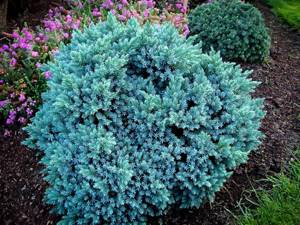
Juniperus squamata
Scaly species or Juniperus squamata
- The variety is native to the mountains of China and Taiwan.
- Today, certain varieties are found in Russia.
- Most representatives of the species have a creeping dense crown. Depending on the variety
- The scaly type of juniper is distinguished by different colors of needles, the length of which reaches 8 millimeters.
- The shape of the cones is oval, with a dark purple color palette.
- To date, 10 varieties of Juniperus squamata are known.
Blue Star
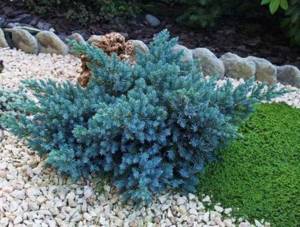
Blue Star
Blue Star
- The name of the variety is due to the unusual color of the spherical crown.
- The needles are blue-green in color with shades of blue and silver.
- The low-growing shrub reaches a height of one meter and has highly branching shoots densely covered with needle-type needles.
Application in landscape design
Well, of course, it’s a matter of style, one might even say trend. In what landscape design options will vertical juniper look most organic? This is definitely a Scandinavian style with its strict geometry and exciting northern aesthetics. Tall and frost-resistant varieties are especially suitable. Although dwarf options (typical for that area) will highlight it just perfectly!
Traditional English style also cannot do without blue and green varieties of juniper, emphasizing the elegance and light-sad composition of the estate and garden. These are ideal planting options. However, nothing prevents you from showing your imagination and adapting juniper to your existing style, playing with shapes and compositions, practicing different designs of garden paths with junipers, fences, swimming pools, gazebos, etc. Experiment, plant and let your landscape design be truly original!
Reproduction
Many gardeners choose juniper to decorate their summer cottage.
Plant propagation is carried out in three main ways:
- Planting seed material.
- Planting cuttings.
- Reproduction by layering.
Recommendations for juniper propagation
The technique consists of the following simple steps:
- Selection of ripe fruits. The dark color of the cones indicates their readiness to be harvested.
- Soaking fruits for easy extraction of seed material
- Seed preparation - immersion in a weak, acidic composition for three hours
- Preparing the soil for planting
- Mulching when planting seeds in open ground
When growing a plant from seed material, the seedling should be transplanted into open ground before the age of four years.
The method of propagation by cuttings and layering is considered more effective. In the first case, preparatory work begins in February - for spring planting or June - for summer planting. It takes about a month to obtain the root system, and the rooting period is two months. Cuttings are the optimal method for propagating juniper.
The procedure consists of the following steps:
- Planting material is cut from the top of the plant. The cutting should not be woody
- Cutting is recommended to be done in the evening or morning, before the sun appears. The approach helps preserve the health of the host and planting material
- A cutting length of up to 25 centimeters is required
- The lower part of the cutting is 5 centimeters, cleared of branches
- Preparing the container and soil for planting
- Planting depth 2-3 centimeters
- Do not allow direct sunlight to hit the plant; only diffused lighting is suitable.
- Timely watering of plantings
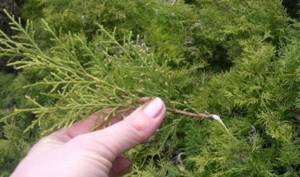
Propagation by cuttings
Propagation of juniper by layering is suitable for creeping varieties.
The procedure includes the following steps:
- Preparing the mother plant - loosening the soil and abundant watering
- Soil preparation - organizing a drainage layer, adding peat and humus
- Cutting a young shoot up to 30 centimeters long
- Removing all branches from the planting material, only from five centimeters of the heel
- The bare part of the branch is pressed against the prepared soil and secured with wire or rope made of synthetic material.
- Mulching planting
- Carrying out regular planting care
Growing in open ground
Juniper is popular in summer cottages. The plant plays a decorative role, looks impressive and has beneficial properties.
Having decided to improve the garden with one of the varieties of coniferous plants, you should start with a seedling. You should purchase it from one of the nurseries. In specialized garden centers, plants are sold with a closed root system, which ensures their safety and health.
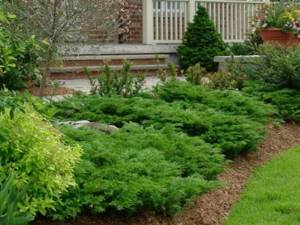
Juniper in a garden plot
When purchasing, you should give preference to seedlings with green and well-bending needles . The branches and trunk should not have mechanical damage. The bright color of the needles indicates good health of the juniper.
Landing
The planting site should be in a well-lit part of the site. Some varieties will feel comfortable in partial shade. When planting a group of plants, maintain a distance of at least 50 centimeters between plantings. The distance can be increased to 200 centimeters depending on the expected size of the plant.
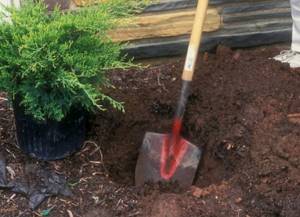
Landing
The pit for planting must be prepared in advance. Its depth is at least 50 centimeters, and its diameter should be at least twice the size of the earthen clod.
- The first layer of the pit is drainage. (Gravel, crushed brick, crushed stone or pebbles are suitable for it.)
- The second layer is sand.
- The third layer is fertile soil.
Juniper is not picky about the composition of the soil, but a fertile layer will speed up the development of a shrub or tree. Depending on the plant variety, preferences for soil composition should be taken into account.
Care measures
- A young, newly planted bush requires regular watering. The event should be carried out at least once a week, in the absence of daily precipitation.
- An adult plant requires virtually no watering. Only if the summer is dry should the soil around the bush or tree be moistened. The number of waterings will be up to three during the entire summer period.
- In dry summers, the plant responds positively to spraying from a spray bottle.
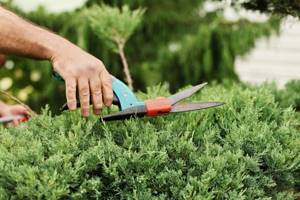
Carrying out sanitary pruning
- The plant does not need regular feeding. It is recommended to apply complex mineral fertilizer only to young seedlings in mid or late spring. At the beginning of spring, it is possible to carry out sanitary pruning of conifers. In the future, pruning takes place only for decorative purposes, to give the crown the desired shape.
When pruning a plant, you must wear gloves. Protective clothing will protect your skin from tar and irritation.
- To preserve the beauty of the crown, the plant is shaded at the beginning of the spring period. This event will help you avoid sunburn. As protection, a bag is thrown over the juniper or special screens are installed.
Growing at home
Certain varieties of juniper are suitable for growing at home in a pot.
When deciding to decorate your apartment with an evergreen plant, you should follow the following recommendations:
- Choosing a large container made of natural material: porcelain or ceramics. The root system of the plant loves space
- Pre-prepared soil should consist of a drainage and fertile layer
- The main danger to growth and development is dry air and high temperature . The room temperature should not exceed 25 degrees
- The place for the plant should be well lit and not in a draft.
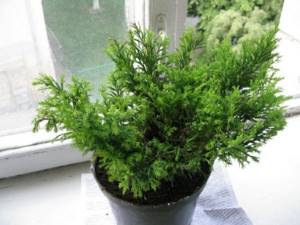
Pot of juniper
In summer, the juniper pot can be taken out into the fresh air.
Houseplant care
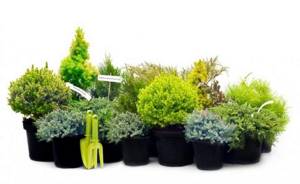
Houseplants
The plant will delight its owner for many years if simple care rules are followed:
- Moderate watering . The activity should be carried out more often in the summer, when the top layer of soil is dry. Regularity of watering during hot periods - once every two days
- Feeding the plant during the period of active growth . When watering, mineral fertilizers are added to the water. In winter, fertilizing is not carried out
- Plant pruning . Removal of dried branches takes place once a year
Basic conditions for growing juniper from seeds
One of the main conditions for growing juniper from seeds is to use only freshly harvested planting material. When stored under normal conditions, germination is lost after 1-2 years.
Seeds should be collected in the fall, as soon as the pine cones ripen. To improve germination, they must be removed from the fruit and washed. The seeds have very hard shells, without breaking which they cannot germinate. In addition, the seed embryo is not ready for germination, as it is at rest. In nature, the process of breaking the integument takes place in the stomach of birds that swallow the seeds, and the awakening of the embryo occurs after a long stay in the soil.
In garden culture for growing juniper, the seeds are scarified, that is, the integument is artificially disturbed. For junipers, the best method is chemical, in which dry seeds are placed in sulfuric acid for 30 minutes and then carefully washed. After this treatment, the seeds are sown in open ground. They germinate by spring.
Another method of seed germination is also possible, based on combined stratification, creating ideal conditions for the awakening of the embryo. Immediately after collecting and cleaning the seeds, they are mixed with coarse, clean, slightly damp sand, sawdust or sphagnum moss, placed in plastic bags and stored for 2-3 months at a temperature of +20 to +30 ° C. Subsequently, the seeds are stored for 3-4 months in the refrigerator or basement at a temperature of +3...+5 °C. During the stratification period, it is necessary to maintain an even, moderate level of substrate moisture and avoid temperature fluctuations.
In spring, stratified seeds are washed and sown in boxes or bowls. The crops are placed in a warm (+18…+23 °C) place, where they germinate. The seedlings are kept in the light, but not in the bright sun, and watered moderately, if necessary they are planted. After hardening in the fresh air, they are planted in a ridge.
To simplify the process, seeds after stratification can be immediately sown in open ground ridges. The combination of chemical scarification with further stratification guarantees a higher germination percentage.
When propagated by seed, varietal varieties weakly repeat their characteristic characteristics, and it is very difficult to identify them in the first year. To propagate varietal forms, vegetative propagation is used.
Collection and use
Juniper is a plant known for its medicinal properties. For preparations, mature cones are used. The optimal collection time is from late summer to mid-autumn. A fabric or paper flooring is placed under the tree. The plant is shaken and fallen, ripe berries are collected.
After drying, the workpiece is used for the following health problems:
- Diseases of the kidneys and urinary system
- Nervous system disorder
- Diseases of the gastrointestinal tract
- Pulmonary diseases. The decoction is used for rinsing and inhalation.
- Cystitis
- Cholelithiasis
- Skin diseases
- Rheumatism. An infusion of cones is added to baths and compresses.
- Lack of menstruation
- Strengthening hair follicles, preventing hair loss
- Diathesis
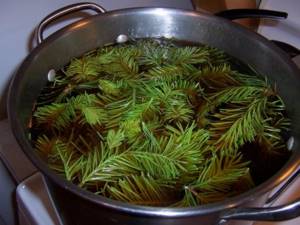
Juniper infusion
Gargle the throat and mouth with an infusion of juniper berries. The solution has a disinfecting effect and allows you to cope with the infection. Not only the fruits, but also the branches of the plant are used for medicinal purposes. They are able to ozonize the air and destroy microbes. The smoke produced by burning juniper has disinfectant properties.
Medicinal properties
The wide medicinal potential of juniper has been known since the times of the Greco-Roman Empire. Both of them constantly mentioned the power of the coniferous plant in written sources. If you believe the mythical legends, then it was with the help of the persistent juniper aroma that Jason and Medea put to sleep the huge serpent guarding the Golden Fleece of Colchis.
In ancient Rus', plant branches used to ward off evil spirits, attributing magical powers to them. And geologists have always believed that in the places where it grows there lies a layer of minerals.
Surprisingly, juniper occupies a leading place among all conifers in terms of the number of essential oils that have a bactericidal effect. For example, just one hectare of juniper grove is capable of releasing in a day such an amount of useful substances, which is more than enough to improve the health of a large city.
Separately, it is necessary to say about the fruits. In pre-revolutionary Russia, sugar was obtained from them. Cone berries also contain pectins and tannins, a number of vitamins and organic acids. This gives them a tart, spicy taste. It is no coincidence that they are added to many tinctures and alcoholic drinks. For example, juniper berries are a classic flavor component of gin. When ground, they are aromatic spices, for which they are valued in European cooking.
Juniper fruits have a choleretic and diuretic effect, stimulate digestion, and are a disinfectant and anti-inflammatory agent. They are used in cosmetology and perfumery. So this shrub, modest at first glance, has remarkable strength.


